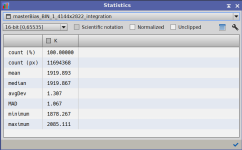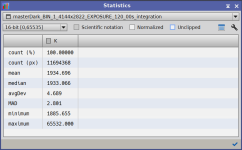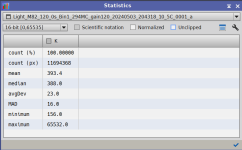M82 - Google Drive
 drive.google.com
drive.google.com
I don't normally compare files in this way but maybe someone can tell me if it's normal to get a master light like this when integrating registered file like the one included.
 drive.google.com
drive.google.com
The concepts of gain and offset are proprietary, camera specific things that no software (other, perhaps, than software that ships with the camera) can do anything with. PI ignores them. When those values are mismatched between different image types it almost always leads to failed calibration, and the only way you know is because it looks bad. And forces you to go back to your source images and figure out that the offsets or gains weren't the same. And sometimes, you'll get bad results if the frames were collected with different software (even if it all claims the same gain and offset values) or even just a camera driver update will change things.As the old saying goes...when in doubt, reboot. Upon rebooting and reopening PI, everything is working again. I'm guessing that somewhere, some process/action was not releasing memory properly. Don't know if this was PI or Windows but at least I got things going again. I repeated the run of removing it flats and it worked as well, and showed that the flats had actually done a lot to reduce the vignetting and that the worst of it was apparently from the amp glow which showed up on the master as black, instead of white. Anybody see anything like that before?
While doing this, I discovered that my lights from last night, which should have been done at a gain of 120 were showing as being done at 111 (what I use for the ASI183). I am pretty sure that I made the appropriate change when I put the new camera in, and I always doublecheck settings when I start up, but I suppose it's possible I missed it. My flats, which I did after finishing last nights run, were the correct 120 though and I absolutely KNOW that I didn't make any changes in between runs. At any rate, WBPP went with it. I didn't think that it would accept a mismatch of gains between light frames and calibration frames. Could this lead to messy vignette and the weird amp glow?
Looks about right. Obviously the calibration has problems, but I think we already knew that.M82 - Google Drive
drive.google.com
I don't normally compare files in this way but maybe someone can tell me if it's normal to get a master light like this when integrating registered file like the one included.
M82 - Google Drive
drive.google.com
I don't normally compare files in this way but maybe someone can tell me if it's normal to get a master light like this when integrating registered file like the one included.
 drive.google.com
drive.google.com
Upload 5 of your raw lights and your calibration masters.Last night I imaged M82 again, from scratch. I shot 92 frames, blinked them. Ran them in SubframeSelector and tossed 4. Ran them in WBPP, making no changes from my previous run, except to disable drizzling. I double checked to ensure all the calibration files matched up for exposure times and gain, etc. It's failing again. I have never seen a "Failed to measure" error before and I'm not sure how that is supposed to work. The ImageSalver kept popping up and I would dutifully make the entries but they never seemed to take and I finally had to cancel it. Then Local Normalization failed , followed by ImageIntegration. The pedestal was set to Auto and CosmeticCorrection was was enabled. Hot pixel removal was 2 and Noise reduction was 3. ImageSolver parameters appeared to be correct. Here is the log:
20240504210030.log
drive.google.com
I imaged this galaxy last year, in April, and had no difficulties and got a pretty good image. At that time I believe that I was using the default settings in WBPP.
 drive.google.com
drive.google.com
 drive.google.com
drive.google.com
There's a huge mismatch between the master dark and the raw lights which makes it impossible to calibrate. The dark background mean is around 2000, and the light is about 400, so calibration subtracts off almost all the signal. Maybe a gain or offset mismatch.Have you found anything with the files I posted?
I can't say where the problem came from, only that the darkest pixels in your dark are a lot brighter than the darkest pixels in your lights, which cannot work. You can see this either by clicking and scanning over the images, or by using the Statistics process on these files. SFS doesn't change the pixel value in the files it writes, and you can see the same problem in both the FITS and the XISF versions.I'm not sure what those numbers represent. Where did you find them? I didn't use a previously created master dark, it was created from 30 darks from a dark library. Was the problem due to the capture process did it arise during the calibration or some other point? The lights that I use are always xisf files generated by SubframeSelector. Would they exhibit the same mismatch? Last night I imaged using my RASA8 with the ASI183 and no filter. I calibrated and stacked 66 images, 60 secs, 111 gain, with 30 darks, no flats, no bias. Everything went smoothly, with the exact WBPP settings except for the pedestal at Auto. I took that off since I didn't use a filter.
I'm trying to get an understanding so I'll know what to change.
I agree that the header values appear correct. But the most casual examination of the images shows that the darks are lighter than the lights. So something went terribly wrong somewhere.I must be doing something wrong. I went to the files that I last sent you and opened one of the darks that were used to create the master dark and one of the raw lights. I looked at the FITS headers of both and they both said 30 (I could only show one at a time for the screen shot). The gains and exposures of both are displayed in the titles of the files and all of them say 120. What am I missing? Am I looking in the wrong place?
OK, used the ColorSaturation process and found that the pixels in the Light were mainly just over 0.007 and the pixels in the Dark were just over 0.029. Does this constitute evidence of what you describe?I can't say where the problem came from, only that the darkest pixels in your dark are a lot brighter than the darkest pixels in your lights, which cannot work. You can see this either by clicking and scanning over the images, or by using the Statistics process on these files. SFS doesn't change the pixel value in the files it writes, and you can see the same problem in both the FITS and the XISF versions.
I'd go back to the source files (FITS) used to create the master dark you provided and check the gain and offset values against those in the FITS headers of your lights.
If you had left the lens cap on the telescope the light couldn't have pixels of lower value than your dark (other than variation from noise). This has nothing to do with your filters. Your master bias has a mean level of 1920. Your master dark has a mean level of 1935. Your light has a mean level of 393. That makes no sense, and there's no way you can use those calibration frames with those lights.The only difference I can think of is the use of the Antlia Triband filter, which I had never used before at the F10 of the C11 with the reducer. Do you think that could have caused this? I guess I'll test it tonight.



I'd need to see your master dark and one of your light subs. But if the background of the dark is higher than the background of the light, the final result is not what it should be, even if it makes it through WBPP. There's really no way the dark can be lighter than the light unless you're somehow taking them under very different camera settings (like using a different program for each).I must be misunderstanding something. I checked the Mean of one of the lights that I shot last night and it was 1956.1. Then I checked the Mean of one of the darks that I would use to calibrate these lights and it was 2349.9. By my understanding, this would mean that the dark is lighter than the background of the light and therefore WBPP would be unable to calibrate the lights and would fail to integrate anything and get a masterlight. Then I tried a number of things, including creating another dark with my camera in a lightproof bag used to change film in the old days, to see if there was any light leak, but Mean was the same. I decided to run it through WBPP anyway, to see what would happen, and it ran flawlessly and produced a good masterlight. I calibrated with bias and darks but not flats as I didn't have any for this setup. Can you tell me what I'm missing?
 drive.google.com
drive.google.com
